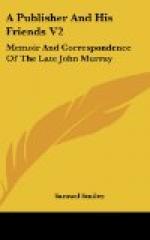At the beginning of October Mr. Murray set out for Edinburgh, journeying by Nottingham for the purpose of visiting Newstead Abbey.
The following is Mr. Murray’s account of his visit to Newstead. His letter is dated Matlock, October 5, 1814:
“I got to Newstead about 11 o’clock yesterday and found the steward, my namesake, and the butler waiting for me. The first, who is good-looking and a respectable old man of about sixty-five years, showed me over the house and grounds, which occupied two hours, for I was anxious to examine everything. But never was I more disappointed, for my notions, I suppose, had been raised to the romantic. I had surmised the possibly easy restoration of this once famous abbey, the mere skeleton of which is now fast crumbling to ruin. Lord Byron’s immediate predecessor stripped the whole place of all that was splendid and interesting; and you may judge of what he must have done to the mansion when inform you that he converted the ground, which used to be covered with the finest trees, like a forest, into an absolute desert. Not a tree is left standing, and the wood thus shamefully cut down was sold in one day for L60,000. The hall of entrance has about eighteen large niches, which had been filled with statues, and the side walls covered with family portraits and armour. All these have been mercilessly torn down, as well as the magnificent fireplace, and sold. All the beautiful paintings which filled the galleries—valued at that day at L80,000—have disappeared, and the whole place is crumbling into dust. No sum short of L100,000 would make the place habitable. Lord Byron’s few apartments contain some modern upholstery, but serve only to show what ought to have been there. They are now digging round the cloisters for a traditionary cannon, and in their progress, about five days ago, they discovered a corpse in too decayed a state to admit of removal. I saw the drinking-skull [Footnote: When the father of the present Mr. Murray was a student in Edinburgh, he wrote to his father (April 10,1827): “I saw yesterday at a jeweller’s shop in Edinburgh a great curiosity, no less than Lord Byron’s skull cup, upon which he wrote the poem. It is for sale; the owner, whose name I could not learn (it appears he does not wish it known), wants L200 for it.”] and the marble mausoleum erected over Lord Byron’s dog. I came away with my heart aching and full of melancholy reflections—producing




